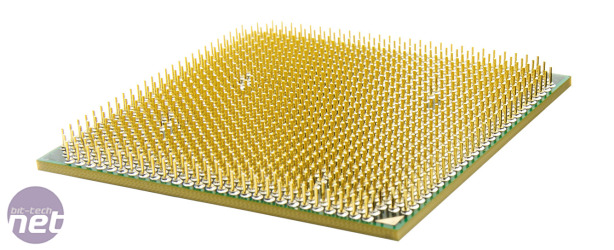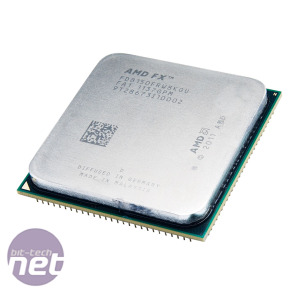AMD FX-8150 Stock-speed Performance
The novel Bulldozer design of the FX-8150 seems to be light on performance per core, as our image editing test shows. This test is single-threaded, and the FX-8150 fared extremely poorly with a stock-speed score of 887. To put that into context, a Core 2 Duo E6700 is 13 per cent faster and a Core i5-2500K is almost twice as fast as the FX-8150 in this kind of situation.The poor single-thread performance was an Achilles’ heel for the FX-8150 in games too, as game developers are still struggling to load-balance their games threads, even if they can thread certain sub-tasks such as physics, objection collision, pathfinding and so on. Arma II has one major thread that can saturate an execution core, so to run Arma II well, a CPU needs at least one fast core (whether that’s via high IPC or high frequency, or both). Having multiple other cores helps keeps the minimum frame rate up, as these other cores can handle the other threads, leaving one core to process that main thread as quickly as possible.
Given the poor single-thread performance of the FX-8150, the relatively low level of performance in Arma II wasn’t a surprise. The stock-speed minimum frame rate of 61fps was only 2fps faster than that of the Phenom II X6 1100T Black Edition; the Core i5-2500K managed a minimum 86fps, some 41 per cent faster.
Worse still, Shogun 2 refused to run at all on the FX-8150 – when the CPU tried to load the level, the system would hang and restart. We raised this with AMD and were told, ‘we have also seen this issue and are working on a solution.’ We were told that this was only an issue with the Steam version of the game, but nothing more. However, running Shogun 2 on the Phenom II X6, we saw the same characteristics as with Arma II – there’s a main thread that tends to butt up against the processing limit of one of the cores, even though the game is multi-threaded.
Multi-threaded performance
While the single-thread performance of the FX-8150 was dire for a brand new CPU architecture launched in 2011, the multi-threaded performance was even more disappointing. If we take Cinebench R11.5 as the quintessential example of an ideally multi-threaded application (it scales to n cores and uses 100 per cent of each of them) and a bit of fag-packet maths, we can illustrate what we mean.The Phenom II X6 has six cores operating at 3.3GHz, which gives it an eBay frequency of 19.8GHz; the FX-8150 has eight cores at 3.6GHz giving it an comparable speed of 28.8GHz – an increase of 45 per cent. However, the Cinebench score of 6.01 is only 2.6 per cent faster than the 5.86 of the Phenom II X6 1100T. That’s a poor result for the FX-8150 and indicates that each of those eight cores aren’t a match for any of the six within the Phenom II. The 8-core FX-8150 was only marginally faster than the quad-core Core i5-2500K, which managed 5.93. The Hyper-Threaded Core i7-2600K was much faster than the FX-8150, though, with a score of 7.49.
WPrime 2.05 – another n-threaded application that will saturate each execution core it’s given – also showed comparably poor results from the FX-8150. The Phenom II X6 1100T was actually quicker, processing the work across its six cores in 8.301 seconds rather than the 9.484 seconds that the eight cores of the FX-8150 took. At least that was faster than the Core i5-2500K, which took 9.985 seconds, even if the Core i7-2600K only took 7.303 seconds for the same work.
In our video encoding test we saw the FX-8150 start to show some of the performance we’d expect of an 8-core CPU. The score of 2,520 is comfortably ahead of the Phenom II X6 1100T and the eight-thread (quad-core but Hyper-Threaded) Core i7-920. However, the quad-core Core i5-2500K was faster still with a score of 2,997 while the 8-way Core i7-2600K was even faster with a score of 3,211 points.
We saw the same pattern from the multi-tasking test, where the FX-8150 outpaced the Core i7-920 and the Phenom II X6 1100T, but lagged behind the two Sandy Bridge processors by some margin. Overall, the FX-8150 could only muster 1,563 points – enough to beat the Phenom II X6 1100T and Core i7-920 by a whisker (47 and 119 points respectively). However, the Core i5-2500K and Core i7-2600K were streets ahead with overall scores of 2,116 and 2,217 respectively.
Power Consumption
The glimmer of hope in a miserable set of results is the FX-8150’s power draw when idle – with our test system drawing only 110W from the wall, the FX-8150 was the most frugal processor on test when idle. This might not sound much – especially as the FX-8150 was only middling when it came to power consumption when the CPUs were under load – but it shows that AMD has nailed power gating at the first time of asking.Moreover, Intel is obsessed with lowering power consumption, talking at length about special circuits in its Sandy Bridge design that are more complex than entire CPUs of ten years ago. This obsession manifested itself in the entire design strategy of Sandy Bridge, which is really a CPU made for laptops that merely happens to be very fast. That a processor designed for high performance desktops (and workstations and servers) has a lower idle power draw than a Sandy Bridge CPU is a marvel and deserving of much praise.

MSI MPG Velox 100R Chassis Review
October 14 2021 | 15:04












Want to comment? Please log in.